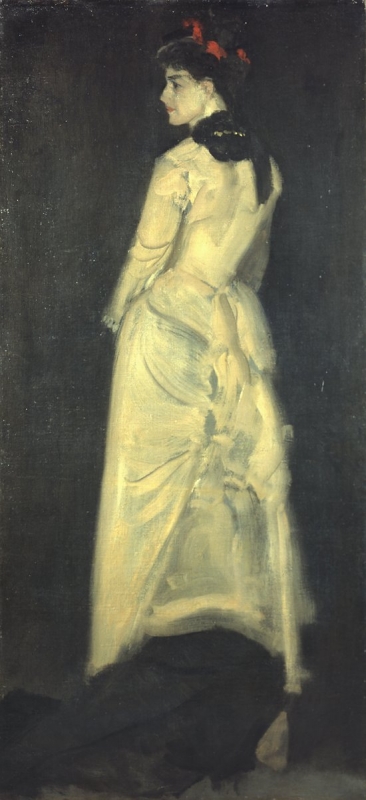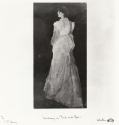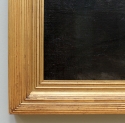Home > Catalogue > Browse > Harmony in Flesh Colour and Black: Portrait of Mrs Louise Jopling << >>
Composition
In pose and costume Whistler's portrait of Mrs Jopling closely resembles Harmony in Pink and Red [YMSM 192], a portrait of Maud Franklin (1857-1939). In colour this was closer to the colours mentioned by Jopling in her account of the 1878 sitting, except that the model was not wearing a tocque.
Technique
The canvas is a very coarse-woven tabby, the texture emphasized by the bumps and slubs of the fine close-woven tabby lining. It may have been prepared with a white priming, and certainly with a mid-dark grey imprimatura, the grey making an optical contribution to the ruffled fabric. 1 The coarse canvas provides subtle textures.
As might be expected from E. W. Godwin's account, the portrait was painted extremely fluidly with a broad long-haired brush, up to 3.8 cm (1½") wide, on the dress. The canvas must have been prepared in advance, for Mrs Jopling's face was painted over the dark background. Whistler confidently sketched the figure in grey, followed by sweeping brush strokes in cream and pink applied with a wide soft-haired brush, probably used side-on for the broad strokes.
The face, which is highly finished, is slightly marred by a scratch across the nose, but, with her dark eyes painted slightly more dryly than the rest of the picture, and the hat indicated by broad wet stroke of red, the portrait creates a strikingly dramatic effect.
Patricia de Montfort comments :
'Whistler worked swiftly, blocking in the flesh colour and grey tones of the figure in order to preserve a fluidity of effect within the overall red and white on black colour scheme. The result captures her vivacity and sharp intelligence, qualities that are accentuated by the angular composition and the coarse weave of the canvas support and the subtle gleam of the fabric of her white dress.' 2
Conservation History
The lined canvas is in excellent condition apart from lead soap aggregates that are beginning to push through. This, and the thin paint (which, though thin, has not run), suggests the use of a ‘sauce’ (or megilp) with added lead driers. The lining has caused some weave-interference. 3
There are widespread signs of abrasion, possibly by the artist, and possibly as part of the painting process. The support and paint are basically in sound condition, though the canvas may have been folded at some time, and there are some signs of paint loss and cracking. The canvas was extended with a 2-2.5 cm deep band at the top, possibly when the picture was unrolled, repaired, lined, retouched (particularly on the face) and varnished. The varnish is now rather thick, glossy and yellowed. 4
Frame
It is in a Portrait Whistler frame, date unknown. 206.5 x 105.0 x 6.8 cm. 5
Notes:
1: Condition report by Clare Meredith, 5 April 2001, Hunterian files. Analysis by Dr Joyce H. Townsend, April 2017, GU WPP.
2: de Montfort, Patricia, Louise Jopling: a biographical and cultural study of the modern woman artist in Victorian Britain, Abingdon & New York, 2017, p. 81.
3: Townsend 2017, op. cit.
4: Condition report by Clare Meredith, 5 April 2001, Hunterian files.
5: Dr Sarah L. Parkerson Day, Report on frames, 2017; see also Parkerson 2007 [more].
Last updated: 21st May 2021 by Margaret









